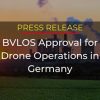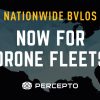Although mining may be the true oldest profession as it has been done for thousands of years, it remains dangerous. The International Council on Mining and Metals notes 7000 mining-related injuries in 2020 alone.
Based on the potential danger involved with mining, it’s no surprise that there are strict rules related to monitoring and inspecting mines. Even inspecting requires special permits. Besides the health and safety element of mine inspections, great precision is required when doing a geological survey and measuring stockpiles. A proper mine inspection allows management to: gain clarity on the amounts of materials on-site, provide accurate stockpile measurements, monitor tailing dams, provide situational awareness of ground stability and ground movement, monitor the temperature of coal, monitor and analyze blasts, assist with emergency response and security, assist with environmental monitoring. Ultimately, they help with preventive maintenance and keep employees safe.
What is a geological survey?
Let’s backtrack a moment and define a geological survey.
First off, note that a geological survey is essential for extracting minerals and hydrocarbons. It can be defined as “A systematic investigation of an area determining the distribution, structure, composition, history, and interrelations of rock units. Its purpose may be either purely scientific or economic with special attention to the distribution, reserves, and potential recovery of mineral resources.”
Once a mine is in operation, its use for a survey would be minimal. However, a survey could help detect if there’s more material to mine.
Drones for mining inspections
Drones are used in mining to inspect sites for safety and efficiency. Specifically, drones can be used to monitor open pits, stockpiles, tailings dams, pipelines – as well as aiding in security and emergency response tasks. They can also be used to monitor equipment such as crushers and conveyors, and to survey work sites during construction. Drones can help reduce costs by reducing the need for expensive and time consuming manual inspections, and can increase productivity by allowing workers to perform tasks from a safe distance.
Stockpile measurement monitoring
AI-powered drones can also help keep track of the inventory of stockpiles. This allows managers to know exactly what is available and where it is located. It also helps to prevent theft and ensure that the correct amount of material is being stored
This saves money by reducing the number of inspectors needed. With fewer people inspecting stockpiles, less manpower is required. Also, since drones can perform these tasks without human intervention, it reduces the cost of training new employees.
The use of drones and AI to inspect stockpiles has many advantages. For example:
- They improve safety by eliminating the risks associated with climbing on top of stockpiles
- They allow for real-time measurements or at the very least high frequency, consistent inspection
- They provide accurate results
- They eliminate the possibility of human error
- They increase efficiency by allowing for remote monitoring
- They reduce the chances of theft by preventing access to stockpiles
How pile inspections were done
Previously, pile inspections were performed largely manually – which meant that workers had to climb onto the piles to check them. The danger was obvious. In addition, the process was slow and labor intensive.
How it’s done today
Drones and AI have changed all that. They have made it possible to remote visual inspection and monitor stockpiles from above. No more need to climb on top of the stockpiles. Instead, you simply send your drone out to do its job.
As an added bonus, if something goes wrong, you can immediately alert management. When you’re inspecting with drones, however, they can do all of those things. They can detect issues before anyone even notices them. They can send alerts if something goes wrong. And they can do all of this while remaining safely out of harm’s way.
Benefits of using drones and AI for mine inspections
Mines need to be measured for multiple reasons, including logistics, safety, and more. In the past, inspections such as measuring a stockpile was a time-consuming and laborious task.
There are multiple benefits to using drones and AI to inspect mines. Let’s review.
Precise information
Every company wants to know how much product/materials it has. Timely and accurate information makes peak performance possible and is crucial to operations.
Using drones and AI for mining inspections means companies will know exactly how much is in the stockpile, how many trucks came in or out, and more. No more guesswork! In addition, the information can be quickly retrieved upon completion of the drone flight. No more waiting for a few days for surveyors to crunch the numbers.
Remote monitoring
Mines are often located in challenging environments with extreme temperatures and weather conditions. Getting a surveyor out to such a location can be a challenge as they may be reluctant to go. Plus, opportunities to go to the site may be limited, due to weather conditions.
Because of the challenges of surveying the mine, inspections may occur less frequently than is ideal. These challenges fall by the wayside when using drones for inspections. Therefore, mine inspections can happen regularly, as intended. More frequent inspections naturally lead to safer conditions and a minimizing of risks.
Increased safety with automated inspections and alerts
Risky inspections are a thing of the past. Sending someone up on a stockpile or to monitor tailings dams with hazardous material is potentially dangerous.
A drone can be easily programmed to fly over stockpiles and any other area in and around the mine and quickly deliver precise information. So, no one needs to put themselves at risk.
In addition, drones can measure the precise slope and height of the piles or tailings walls. If the AI detects a potential issue, it automatically alerts management. Management can act accordingly and alter the slope and height so it is safe.
Stay within regulations
Because materials at mines are often sensitive and because mines can be dangerous, there are strict regulations related to how a mine operates and is maintained.
In addition to regulations related to the slope and height of a stockpile, mines must adhere to wastewater, leak and tailings dam regulations, in addition to general employee safety conventions. Since drones accurately monitor this information, mining companies can take action to make sure they stay within regulations and avoid costly fines.
Percepto AIM takes mine inspections to the next level
With Percepto’s AIM, inspections can be automated and done remotely. Drones inspections can be monitored and managed by someone offsite. This feature is especially helpful during emergencies when access to the site may be limited. The drone can inspect the site and detect issues such as fires or rock slides, allowing management to address them quickly and lessen damage.
Upon completion of the flight, the captured data is uploaded to the cloud, where it is organized and analyzed. Detailed reports are quickly generated (as well as a 3D model) and include useful information such as amounts in a stockpile. In addition, the AI can compare data gathered from previous flights and send out alerts about issues/potential issues as needed. It’s also easy to share the information with all the necessary parties.
One of the oldest professions is much easier and safer when using drones to inspect mines. With Percepto AIM companies can maximize their mine profits and be on top of any potential danger signs.





